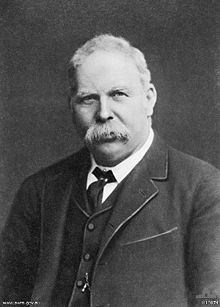Samuel McCaughey
| Sir Samuel McCaughey | |
|---|---|

Portrait of Sir Samuel McCaughey
|
|
| Born |
1 July 1835 Tullyneuh, Ireland |
| Died | 25 July 1919 (aged 84) Yanco, New South Wales |
Sir Samuel McCaughey (1 July 1835 – 25 July 1919) was an Irish-born pastoralist, politician and philanthropist in Australia.
McCaughey was born at Tullynewey, near Ballymena, Ireland, the son of Francis McCaughey, farmer and merchant, and his wife Eliza, née Wilson.
McCaughey came to Australia with an uncle, Charles Wilson, a brother of Sir Samuel Wilson and landed at Melbourne in April 1856. He immediately went to the country and began working as a , in three months was appointed an overseer, and two years later became manager of Kewell station while his uncle was on a visit to England.
In 1860, after his uncle's return, he acquired an interest in Coonong station near Urana with two partners. His brother John who came out later became a partner in other stations.
During the early days of Coonong station McCaughey suffered greatly from drought conditions, but overcame these by sinking bores for artesian water and constructing large tanks and so was a pioneer of water-conservation in Australia.
In 1871 McCaughey was away from Australia for two years on holiday, and on his return did much experimenting in sheep-breeding, at first seeking the strains that could produce the best wool in the Riverina district, and afterwards when the mutton trade developed considering the question from that angle.
In 1880 when Sir Samuel Wilson went to England, McCaughey bought two of his stations, Toorale and Dunlop Stations. McCaughey then owned about 3,000,000 acres (12,000 km²). In 1886 when he again visited the old world he imported a considerable number of Vermont sheep from the United States, and he also introduced fresh strains from Tasmania.
In 1900 McCaughey bought North Yanco and at great cost constructed about 200 miles of channels and irrigated 40,000 acres (160 km²). The success of this scheme is believed to have encouraged the New South Wales government to proceed with the dam at Burrinjuck.
...
Wikipedia
